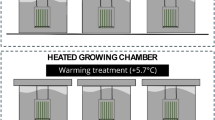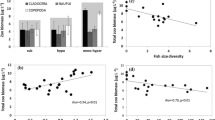Abstract
The relative contribution of autotrophic carbon sources (aquatic macrophytes, flooded forest, phytoplankton) for heterotrophic bacterioplankton was evaluated in a floodplain lake of the Central Amazon. Stable carbon isotopes (δ13C) were used as tracers. Values of δ13C of different autotrophic sources were compared to those of dissolved organic carbon (DOC) and those of bacterially produced CO2.
The percentage of carbon derived from C4 macrophytes for bacterially produced CO2 was the highest, on average 89%. The average δ13C value of CO2 from bacterial respiration was −18.5 ± 3.3‰. Considering a fractionation of CO2 of 3‰ by bacterial respiration, δ13C value was −15.5‰, near C4 macrophyte δ13C value (−13.1‰).
The average value of total DOC δ13C was −26.8 ± 2.4‰. The percentage of C4 macrophytes carbon for total DOC was on average 17%. Considering that bacteria consume mainly carbon from macrophytes, the dominance of C3 plants for total DOC probably reflects a faster consumption of the former source, rather than a major contribution of the latter source.
Heterotrophic bacterioplankton in the floodplain may be an important link in the aquatic food web, transferring the carbon from C4 macrophytes to the consumers.
Similar content being viewed by others
References
Araujo-Lima, C. A. R. M., B. R. Forsberg, R. Victoria & L. Martinelli 1986. Energy Sources for detritivorous fishes in the Amazon. Science 34: 1256–1258.
Araujo-Lima, C. A. R. M. & E. Hardy. 1987. Aspectos biológicos de peixes amazônicos. VIII. A alimentação dos alevinos do laraqui, Semaprochilodus insignis. Amazoniana 5: 127–136.
Azam, F., T. Fenchel, J. Field, J. S. Gray A, L. A. Meyer-Reil & F. Thingstad, 1983. The ecological role of water-column microbes in the sea. Mar. Ecol. Prog. Ser. 10: 257–263.
Bayley. P. B., 1983. Central Amazon fish populations: biomass, production and some dynamics characteristics. Ph. D. Thesis, Dalhousie Univ. Nova Scotia, Canada, 330 pp.
Benner, R., S. Opsahl, G. Chin-Leo, J. E. Richey & B. R. Forsberg, 1995. Bacterial carbon metabolism in the Amazon River system. Limnol. Oceanogr. 40: 1262–1270.
Blair, N., A. Leu, E. Muñoz, J. Olse, E. Kwong & D. Des Marais, 1985. Carbon isotopic fractionation in heterotrophic microbial metabolism. Appl. envir. Microbiol. 50: 996–1001.
Coffin, R. B., D. J. Velinsky, R. Devereux, W. A. Price & L. A. Cifuentes, 1990. Stable Carbon Isotope analysis of nucleic acids to trace sources of dissolved substrates used by estuarine bacteria. Appl. Envir. Microbiol. 56: 2012–2020.
Coffin. R. B., B. Fry, B. J. Peterson & R. T. Wright, 1989. Carbon isotope composition of estuarine bacteria. Limnol. Oceanogr. 34: 1305–1310.
De Niro, M. J. & S. Epstein, 1978. Influence of diet on distribution of carbon in animals. Geochim. Cosmochim. Acta 42: 495–506.
Ducklow, H. W., D. A. Purdie, P. J. L. B. Williams & J. M. Davies, 1986. Bacterioplankton: a sink for carbon in a coastal plankton community. Science 232: 865–867.
Fenchel, T., 1988. Marine plankton food chains. Annu. Rev. Ecol. Syst. 19: 19–38.
Fenchel, T. M. & B. B. Jorgensen, 1977. Detritus food chains of aquatic ecosystems, the role of bacteria. In Alexander, M. (ed.), Advances in microbial ecology. Plenum, New York: 1–58.
Fernandez, J. M., 1993. Fontes autotróficas de energia em juvenis de jaraqui Semaprochilodus insignis (Schomburgk, 1841) e curimatã, Prochilodus nigricans (Agassiz, 1829) (Pisces:Prochilodontidade) da Amazônia central. M.Sc. Thesis, Instituto Nacional de Pequisas da Amazônia/Universidade Federal do Amazonas, Manaus, 58 pp.
Forsberg, B. R., C. A. R. M. Araujo-Lima, L. A. Martinelli, R. L. Victoria & J. A. Bonassi, 1993. Autotrophic carbon sources for fish of the central Amazon. Ecology 74: 643–652.
Furhman, J. A., 1992. Bacterioplankton roles in cycling of organic matter: the microbial food web. In Falkowsky, P. G. & A. D. Woodhead (eds), Primary productivity and biogeochemical cycles in the sea. Plenum Press. New York: 361–383.
Fry, B. & E. B. Sherr, 1984. δ13C measurements as indicators of carbon flow in marine and freshwater ecosystems. Cont. Mar. Sci. 7: 13–47.
Hedges, J. I., G. L. Cowie, J. E. Richey, P. D. Quay, R. Benner, M. Strom & B. R. Forsberg, 1994. Origins and processing of organic matter in the Amazon River as indicated by carbohydrates an amino acids. Limnol. Oceanogr. 39: 743–761.
Hessen. D. O., 1985. The relation between bacterial carbon and dissolved humic compounds in oligotrophic lakes. FEMS Microbiol. Ecol. 31: 215–223.
Hessen, D. O., 1992. Dissolved organic carbon in a humic lake: effects on bacterial production and respiration. Hydrobiologia 229: 115–123.
Hobbie. J. E., 1992. Microbial control of dissolved organic carbon in lakes: research for the future. Hydrobiologia 229: 169–180.
Howard-Williams, C. & W. J. Junk, 1976. The decomposition of aquatic macrophytes in the floating meadows of a central Amazonian várzea lake. Biogeographica: 115–123.
Howard-Williams, C. & W. J. Junk, 1977. The chemical composition of central Amazonian aquatic macrophytes with special reference to their role in the ecosystem. Arch. Hydrobiol. 79: 446–464.
Junk. W. J., 1970. Investigations on the ecology and production biology of the ‘floating meadows’ (Paspalo-echinoclhoetum) on the middle Amazon. I. The floating vegetation and its ecology. Amazoniana: 449–495.
Junk, W. J., 1973. Investigations on the ecology and production biology of the ‘floating meadows’ (Paspalo-echinoclhoetum) on the middle Amazon. II. The aquatic fauna in the root zone of the floating vegetation. Amazoniana 4: 9–102.
Junk, W. J., 1985. The Amazon floodplain — a sink or source for organic carbon? Mitt. Geol. Paläont. Inst. Univ. Hamburg. SCOPE/UNEP Sonderbd. 58: 267–283.
Junk. W. J. & C. Howard-Williams, 1984. Ecology of aquatic macrophytes in Amazonia. In Sioli, H. (ed.), The Amazon, limnology and landscape ecology of might tropical river and its basin. Junk Publisher, The Hague, 296–293.
Junk. W. J. & K. Furch, 1991. Nutrient dynamics in Amazonian floodplain: decomposition herbaceous plants in aquatic and terrestrial environments. Verh. int. Ver. Limnol. 24: 2080–2084.
Martinelli. L. A., 1986 Composição química e isótopica (δ13C) de sedimentos de várzea e suas interações com alguns rios da bacia Amazônica. M.Sc. Thesis, Universidade de São Paulo, 214 pp.
McManus, G. B. & J. A. Furhman, 1988. Contral of marine bacterio-plankton populations: Measurement and significance of grazing. Hydrobiologia 159: 51–62.
Melack. J. M. & T. R. Fisher, 1991. Comparative limnology of tropical lakes with an emphasis on the central Amazon. Acta Limnol. Brasil. 3: 1–46.
Melack, J. M. & T. R. Fisher. 1983. Diel oxygen variations and their ecological implications in Amazon floodplain lakes. Arch. Hydrobiol. 98: 422–442.
Moran, M. A. & R. E. Hodson, 1990. Bacterial production in humic and nonhumic components of dissolved organic carbon. Limnol. Oceanogr. 35: 1744–1756.
Padovani, C. R., 1992. Determinação das fontes autotróficas de carbono para camarões em um lago de várzea da Arnazônia Central utilizando isótopos estáveis de Carbono. M.Sc. Thesis Instituto Nacional de Pesquisas da Amazônia/Universidade Federal do Amazonas, Manaus, 72 pp.
Peterson, B. J. & B. Fry, 1987. Stable isotopes in ecosystem studies. Annu. Rev. Ecol. Syst. 18: 293–320.
Pomeroy, L. R., 1974. The ocean's food web: a changing paradigm. BioScience 24: 499–504.
Pomeroy, L. R. & W. J. Wiebe, 1988. Energetics of microbial food webs. Hydrobiologia 159: 7–18.
Quay. P., D. O. Wilbur, J. E. Richey, J. I. Hedges, A. H. Devol & R. Victoria, 1992. Carbon cycling in the Amazon: implication from the 13C composition of particles and solutes. Limnol. Oceanogr. 37: 857–871.
Quay. P., D. O. Wilbur, J. E. Richey, H. Devol, R. Benner & B. R. Forsberg, 1995. The 18O:16O of dissolved oxygen in rivers and lakes in the Amazon Basin: Determining the ratio of respiration to photosynthesis rates in freshwaters. Limnol. Oceanogr. 40: 718–729.
Rai, H., 1979. Microbiology of Central Amazon lakes. Amazoniana 6: 583–599.
Rai, H. & G. Hill, 1980. Classification of central Amazon lakes on the basis of their microbiological and physico-chemical characteristics. Hydrobiologia: 85–99.
Rai, H. & G. Hill. 1984. Microbiology of amazonian waters. In Sioli, H. (ed.) The Amazon, limnology and landscape ecology of might tropical river and its basin. Dr W. Junk Publishers, The Hague, 413–444.
Richey. J. E., A. H. Devol, S. C. Wofsy, R. L. Vitoria & M. N. Goes-Ribeiro, 1988. Biogenic gases and the oxidation and reduction of carbon in Amazon river and floodplain waters. Limnol. Oceanogr. 33: 551–561.
Richey. J. E., A. H. Devol, P. D. Quay, R. L. Vitoria, L. A. Martinelli B. R. Forsberg, 1990. Biogeochemistry of carbon in the Amazon River. Linmol. Oceanogr. 35: 352–371.
Salonen, K., P. Kankaala, T. Tulonen, T. Hammat, M. James, T-R. Metsälä & L. Arvola, 1992. Planktonic food chains of highly humic lake. I. A mesocosm experiment during the spring primary production maximum Hydrobiologia 2291: 25–142.
Sherr, E. B., B. F. Sherr & L. J. Albright. 1987. Bacteria: Link or sink? Science 235: 88–89.
Starkweather, P. L., 1980. Aspects of the feeding behavior and trophic ecology of suspension feeding rotifers. Hydrobiologia 73: 891–908.
Tranvik, L., 1992. Allochtonous dissolved organic matter as an energy source for pelagic bacteria and the concept of the microbial loop. Hydrobiologia 229: 107–114.
Tranvik, L. & M. G. Hölfe, 1987. Bacterial growth in mixed cultures on dissolved organic carbon from humic and clear waters. Appl. envir. Microbiol. 53: 482–488.
Turner, J. T. & P. A. Tester, 1992. Zooplankton feeding ecology: bacterivory by metazoan microzooplankton. J. exp. mar. Biol. Ecol. 160: 149–167.
Waichman. A. V., 1985. Fontes autotróficas de carbono para bactérias em um lago de várzea da Amazônia Central. M.Sc. Thesis, Instituto Nacional de Pesquisas da Amazônia/Universidade Federal do Amazonas, Manaus, 75 pp.
Wilkinson, L., 1990. SYSTAT: The system for statistics. Systat, Inc Evanston, IL.
Wissmar, R. C., J. E. Richey & R. F. Stallard, 1981. Plankton metabolism and carbon processes in the Amazon River, its tributaries, and floodplain waters, Peru-Brazil. May–June 1977. Ecology 62: 1622–1633.
Wylie, J. L. & D. J. Currie, 1991. The relative importance of bacteria and algae as food sources for crustacean zooplankton. Limnol. Oceanogr. 36: 708–728.
Zar. J. H., 1984. Bioestatistical analysis. Prentice Hall Inc., Englewood Cliffs, New Jersey, 718 pp.
Author information
Authors and Affiliations
Rights and permissions
About this article
Cite this article
Waichman, A.V. Autotrophic carbon sources for heterotrophic bacterioplankton in a floodplain lake of central Amazon. Hydrobiologia 341, 27–36 (1996). https://doi.org/10.1007/BF00012300
Received:
Revised:
Accepted:
Issue Date:
DOI: https://doi.org/10.1007/BF00012300




